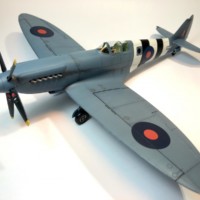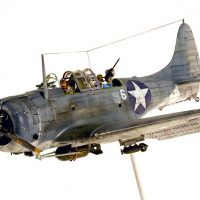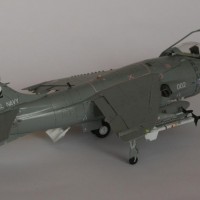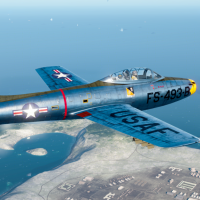Junkers Ju 290 A-5 "Seeadler"
Here’s my build of the Revell Ju-290 A-5 in 1:72. Not my scale, but I have quite a few subjects in 1:72 (or smaller) that interest me. I picked up this big beast at the local hobby shop on impulse a couple of years ago and finally got around to it. It’s a nice kit, the fit was very good, no filler or surgery required. I just had to be careful when handling it during final assembly and painting to prevent knocking off all the delicate antennas, pitot tube, guns, aileron counterweights, and hinges. I painted it as a Seeadler of 1./FAGr.5 based at Roggentin in March of 1945. For some reason at that point in time the port outboard engine cowling was painted overall in the bottom color.
The Ju-290 was one of the best aircraft designs the Nazis came up with, although it was a classic case of “too little, too late”. The origins of the 290 went back to 1936, when the Do-19 and Ju-89 long distance bomber program was cancelled with the death of General Walter Weaver, it’s chief proponent. Research continued into long range bombers, but was delayed until more advanced aircraft could be delivered. The Ju-89 never went into production, but two prototypes were in use with the Luftwaffe in 1940. Junkers decided to use parts of the unfinished Ju-89 to build a long-distance airliner, the Ju-90. The prototype flew in August, 1937 a month after the competing Fw-200. After three prototypes Junkers built 10 Ju-90B-1 production airplanes, most powered by the BMW 132 engines because the Jumo 211s used by the early prototypes were available only for the military. The Ju-90Bs were used by the Luftwaffe as transports but were underpowered and slow. The wing retained the characteristic Junkers trailing edge slats, by now an obsolete feature.
The fourth prototype, Ju 90V4, was given a new modern wing, heavier landing gear, and more powerful engines and designated Ju-90S. (Schwer = heavy). The BMW 139 engine was considered, but the decision to use the BMW 801 was made. That made all the difference.
Also, the rear fuselage incorporated the Trapoklappe, a hydraulically operated loading ramp that could be lowered on the ground until the tail was raised so the cabin floor was level. A winch was installed to load heavy cargo, including vehicles. The ramp could be lowered in flight for dropping cargo and Fallschirmjager troops. Or spies behind enemy lines. The Ju 90V4 was followed by more prototypes with a longer fuselage, more modifications to the wings, more defensive armament, and different tail surfaces. Finally, the Ju 90V11 prototype became the Ju-290V1, which first flew in August of 1942. It was a great success and production started immediately. Two Ju 290A-0 and five Ju 290A-1s were completed as transports and used on the eastern front and the Mediterranean.
The first combat model was the Ju 290A-2 with FuG 200 Hohentweil search radar which could detect a convoy at sea from a distance of 100 km. The Ju 290A-3 was almost identical but had a Focke-Wulf gun turret with a lower profile.The A-4 had an additional dorsal gun turret on the fuselage further aft.
On 15 October FAGr. 5 began operations from Mont-de-Marsan France using two A-2s, three A-3s, and five A-4s replacing the FW 200 on allied shipping reconnaissance operations.
The first A-5s appeared in the spring of 1944. they had protected fuel tanks, armor plating for the crew, larger defensive guns, and the crew was increased from seven to nine. The A-5 was superior to the Fw 200 in every way, but only 11 were completed. By this time, the Atlantic was pretty much in Allied hands and all the Ju 290s were used as transports and some went to KG200.
One A-6 was completed as a personal transport for Hitler but he never used it. It was converted into a 40 seat transport and flew to Spain, where it was used for several years. A few A-7s and A-8s were completed, and the final version, the A-9 had reduced armament but more fuel with a range of 8300km. Ju 290s were built by Letov in Prague, and the production ceased when the Red Army arrived in 1945. After hostilities ceased, Letov finished at least one airliner designated L-290 Orel (Eagle)
The Ju-390 was a radically modified 290, with 6 BMW 801 engines, with longer wings and an extended fuselage. Two Ju-390 prototypes were built and flown. The proposed 290B, C, D, and E models never left the drawing board. Great ideas, but too little, too late, and fortunately for the allies, not enough resources or time to keep things going.















Really nice model, Chas (@chasbunch), especially the mottled camo. The photos are very nice, as well.
Thanks, George.
Really nice result, and the photography's also excellent (as usual).
Thank you, Tom. The photos are half the fun!
Nicely done! What are the chances, just finished one of those myself!
Thanks! Looking forward to seeing yours.
Excellent result and nice historical background, Chas!
Thank you, Spiros.
A wonderful result, Chas @chasbunch
Thanks a lot for sharing the historical part of this not so well known aircraft.
Thanks, John.
How on earth did you do all that delicate mottling, Chas @chasbunch. Fantastic build and very interesting background info. Looks like this would have been a very capable plane.
Thanks, Felix. The camo was easier than I thought it would be. I used a Paasche H airbrush with a #1 tip, experimented on a paint mule with different air pressures, thinner, and distance until I found a suitable combination, then it went pretty fast.
Well done, Chas. 1/72 is not my scale but I would like to build this kit and you're build is more inspiration.
Thanks, Gary. This beast dwarfs some of my 1:48 builds.
Great paintwork on this beast. Looks like a quality kit.
Thanks, John. I was pleasantly surprised by the quality of this kit. OOB except for the spinning props.
Well, it is really impressive and also very nicely done.
Nicely done - that scheme is a stand-out. Looks great!